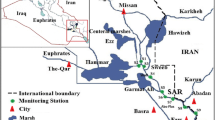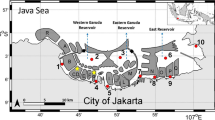Abstract
To achieve better management and conservation, it is important to monitor the salinity of seawater that overlies mudflats and attribute any salinity trend to its potential causes. This study analyzes the salinity trend observed in a semi-enclosed bay and identifies the main causes using numerical modeling. The intertidal mudflat within a Ramsar site in Deep Bay, China is used as a case study. The salinity at the bay’s mouth and toward its interior displayed opposite trends from 1994 to 2007, and previous research has attributed the decreasing salinity over the mudflat in the inner bay to an increase in river flow discharge. However, the simulation results in this study show that the effect of land reclamation during this period was 1.5 times that of the freshwater discharge increase. The effect has propagated from the outer and middle bay to the inner bay, and also to the side where the mudflat is situated. Water mixing due to tides has been weakened, and wind has become more influential in the mixing. Overall, this study is beneficial to other regions considering land reclamation, highlighting its potential effect compared with other factors that could influence the salinity, and thus the overall health of mudflats.









Similar content being viewed by others
References
Blumberg AF, Mellor GL (1987) A description of a three-dimensional coastal ocean circulation model. In: Three-dimensional coastal ocean models 1–16. American Geophysical Union, Washington, DC
Burn DH, Elnur MAH (2002) Detection of hydrologic trends and variability. J Hydrol 255:107–122
Canepa A, Purcell JE, Belmar MB, Acevedo M, Gentile M, Fuentes V (2014) Salinity effects on asexual reproduction of Carybdea sp.(Cnidaria: Cubozoa). J Plankton Res 36:585–590
Castro BM, Moriuchi KS, Friesen ML, Badri M, Nuzhdin SV, Strauss SY, Cook DR, Wettberg E (2013) Parental environments and interactions with conspecifics alter salinity tolerance of offspring in the annual Medicago truncatula. J Ecol 101:1281–1287
Chan SN (2009) Impact of river training on the hydraulics and sediment transport of Shenzhen River. The University of Hong Kong, (Pokfulam, Hong Kong), p. 141. doi:10.5353/th_b4357219
Chan SN, Lee JHW (2010) Impact of river training on the hydraulics of Shenzhen river. J Hydro Environ Res 4:211–223
Chen KP, Jiao JJ (2007) Preliminary study on seawater intrusion and aquifer freshening near reclaimed coastal area of Shenzhen, China. Water Sci Technol Water Supply 2:137–145
Cleveland WS (1979) Robust locally weighted regression and smoothing scatterplots. J Am Stat Assoc 74:829–836
Colijn F, de Jonge VN (1984) Primary production of microphytobenthos in the ems-Dollard estuary. Marine Ecology Progress Series Oldendorf 14:185–196
Cui BS, He Q, Gu BH, Bai JH, Liu XH (2016) China’s coastal wetlands: understanding environmental changes and human impacts for management and conservation. Wetlands 36:1–9
de Mulder EFJ, van Bruchem AJ, Claessen FAM, Hannink G, Hulsbergen JG, Satijn HMC (1994) Environmental impact assessment on land reclamation projects in the Netherlands: a case history. Eng Geol 37:15–23
Galperin B, Kantha LH, Hassid S, Rosati A (1988) A quasi-equilibrium turbulent energy model for geophysical flows. J Atmos Sci 45:55–62
Gao GD, Wang XH, Bao XW (2014) Land reclamation and its impact on tidal dynamics in Jiaozhou Bay, Qingdao, China. Estuar Coast Shelf Sci 151:285–294
Gong WP, Shen J (2011) The response of salt intrusion to changes in river discharge and tidal mixing during the dry season in the Modaomen estuary, China. Cont Shelf Res 31:769–788
Hamrick JM (1992) A three-dimensional environmental fluid dynamics computer code: theoretical and computational aspects. Virginia Institute of Marine Science, College of William and Mary
Hamrick JM, Wu TS (1997) Computational design and optimization of the EFDC/HEM3D surface water hydrodynamic and eutrophication models. p. 143–161. Next Generation Environmental Models and Computational Methods. Society for Industrial and Applied Mathematics, Philadelphia, PA
He Q, Bertness MD, Bruno JF, Li B, Chen GQ, Coverdale TC, Altieri AH, Bai JH, Sun T, Pennings SC (2014) Economic development and coastal ecosystem change in China. Scientific Reports 4:5995
Helsel DR, Hirsch RM (1992) Statistical methods in water resources. Elsevier
Ji ZG, Morton MR, Hamrick JM (2001) Wetting and drying simulation of estuarine processes. Estuar Coast Shelf Sci 53:683–700
Lu QQ, Bai JH, Gao ZQ, Wang JJ, Zhao QQ (2016) Effects of water level and salinity on total sulfur contents in salt marsh soils of the Yellow River Delta. China Wetlands:1–7
Lui TH, Lee SY, Sadovy Y (2002) Macrobenthos of a tidal impoundment at the Mai Po marshes nature reserve, Hong Kong. Hydrobiologia 468:193–211
Mellor GL, Yamada T (1982) Development of a turbulence closure model for geophysical fluid problems. Rev Geophys 20:851–875
Okada T, Nakayama K, Takao T, Furukawa K (2011) Influence of freshwater input and bay reclamation on long-term changes in seawater residence times in Tokyo bay, Japan. Hydrol Process 25:2694–2702
Shen, P. P. 2008. Benthic infaunal community at an intertidal mudflat and molecular analysis of the dominant species Neanthes glandicincta (Polychaeta). HKU Theses Online (HKUTO).
Shen PP, Zhou H, Gu JD (2010) Patterns of polychaete communities in relation to environmental perturbations in a subtropical wetland of Hong Kong. J Mar Biol Assoc U K 90:923–932
Shi JH, Li GX, Wang P (2011) Anthropogenic influences on the tidal prism and water exchanges in Jiaozhou Bay, Qingdao, China. J Coast Res 27:57–72
Singhal, G., Panchang, V. G. and Nelson, J. A. 2013. Sensitivity assessment of wave heights to surface forcing in Cook Inlet, Alaska. Continental Shelf Research, 63, Supplement S50-S62.
Taylor R, Fletcher RL, Raven JA (2001) Preliminary studies on the growth of selected ‘green tide’algae in laboratory culture: effects of irradiance, temperature, salinity and nutrients on growth rate. Bot Mar 44:327–336
Underwood GJC, Kromkamp J (1999) Primary production by phytoplankton and microphytobenthos in estuaries. P. 93–153. In: Nedwell DB, Raffaelli DG (eds) Advances in ecological research. Academic Press
Warrick JA, Madej MA, Goñi MA, Wheatcroft RA (2013) Trends in the suspended-sediment yields of coastal rivers of northern California, 1955–2010. J Hydrol 489:108–123
Xu J, Yin KD, Lee JHW, Liu HB, Ho AYT, Yuan XC, Harrison PJ (2010) Long-term and seasonal changes in nutrients, phytoplankton biomass, and dissolved oxygen in Deep Bay, Hong Kong. Estuar Coasts 33:399–416
Yang Y, Chen XF, Li YY, Xiong M, Shen ZY (2015) Modeling the effects of extreme drought on pollutant transport processes in the Yangtze River estuary. JAWRA Journal of the American Water Resources Association 51:624–636
Ysebaert T, Herman PMJ, Meire P, Craeymeersch J, Verbeek H, Heip CHR (2003) Large-scale spatial patterns in estuaries: estuarine macrobenthic communities in the Schelde estuary, NW Europe. Estuar Coast Shelf Sci 57:335–355
Zhang Y, Cui BS, Xie T, Wang Q, Yan JG (2016) Gradient distribution patterns of rhizosphere bacteria associated with the coastal reclamation. Wetlands 36:69–80
Zhu MS, Sun T, Shao DD (2014) Impact of land reclamation on the evolution of shoreline change and nearshore vegetation distribution in Yangtze River estuary. Wetlands:1–7
Acknowledgments
This work was funded by Seed Funding Programme for Basic Research of The University of Hong Kong (Project code: 201511159044).
Author information
Authors and Affiliations
Corresponding author
Rights and permissions
About this article
Cite this article
Yang, Y., Chui, T.F.M. Potential Causes of Salinity Trend in Seawater Overlaying a Mudflat inside a Semi-Enclosed Bay. Wetlands 36, 831–840 (2016). https://doi.org/10.1007/s13157-016-0792-1
Received:
Accepted:
Published:
Issue Date:
DOI: https://doi.org/10.1007/s13157-016-0792-1




